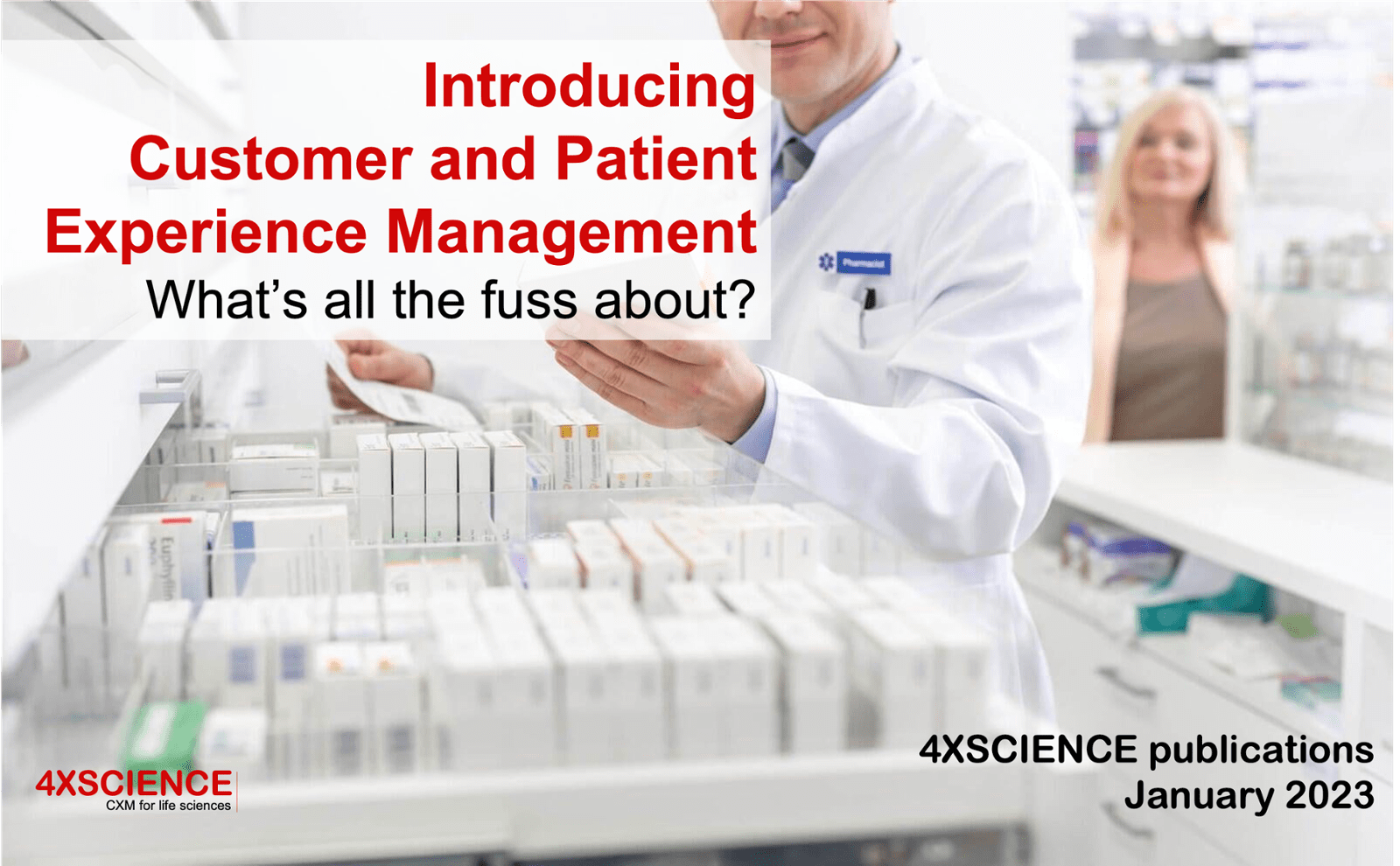
First publication January, 2023. Since a number of years, management of the customer experience (CX) is a hot topic. According to Fortune Business Insights, the global market size for CX technology is estimated to reach 32 billion USD by 2029 with an annual growth rate of 16%. These numbers are applicable to CX related technologies such as SAP, Medallia, Zendesk, Salesforce, all of which the main focus is on capturing and managing selective customer interactions. These solutions represent a small fraction of what customer experience management really is.
Also, in life sciences and the broader healthcare sector, organizations are investing into new technologies that help to enhance customer and patient experiences. The landscape is fragmented: depending on the sector and role in the healthcare value chain, some organizations are heavily proceeding, while others are exploring to understand how experience management could really help them. Some have not heard about customer or patient experience yet, or lack the deeper insights and value. CX concepts used to be driven by teams in sales & marketing or customer services, and mainly as an add-on from CRM. Perceived as another, more advanced attempt to drive up sales through improved satisfaction and loyalty, a kind of advanced digital marketing 2.0.
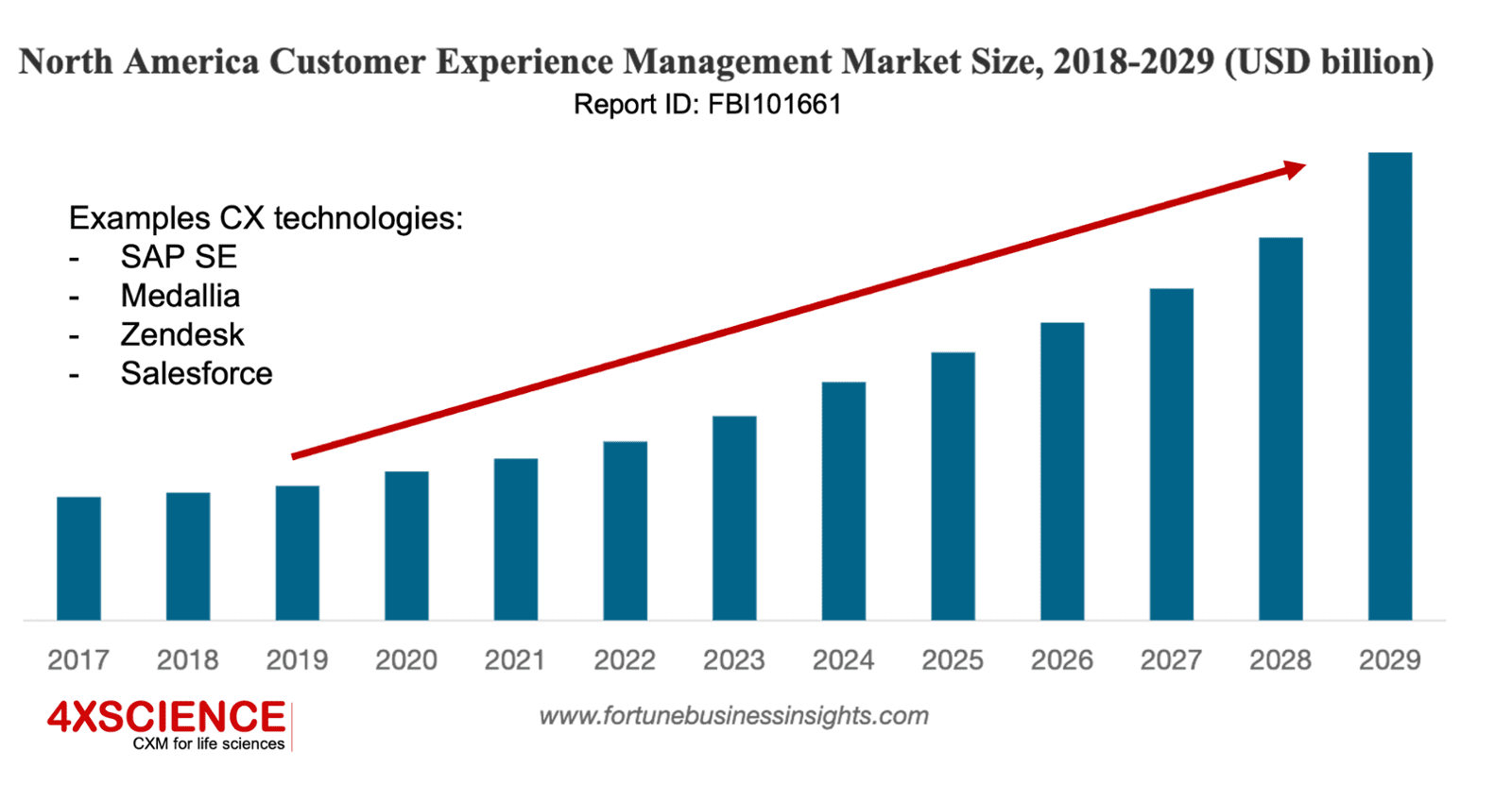
However, more recently, healthcare companies are leveraging CX learnings from other industries into life sciences to the benefit of customers and patients, in a much broader context. Encouraged by new opportunities that are enabled by regulatory authorities (FDA and EMA) and healthcare governments across the globe. The concepts are being implemented in very specific domains, from patient driven product development, over engagement in clinical trials, hospital management, and government reimbursements. CX and PX have become buzzwords, and we see them more and more appearing in business cases of new processes and technologies. Far beyond the original sales and marketing objectives, and with specific domain expertise.
Most life science and healthcare actors have a "patient first" mandate in their mission statement. From large manufacturers to hospitals, even small pharmacies, they all claim to focus on patients first. In the current landscape, competition is increasing in many areas: customers and patients are expecting more from their providers and brands. By stating this mission, companies can't ignore the capabilities enabled by technologies, innovations, and regulators; at least if they are serious about focussing on patients. On the other hand, healthcare manufacturers and providers, must intensively work on improving their relationships with end customers as no other options exist given the current market dynamics. Remember the recent COVID time-to-market competition including the entire experience and perception creation around vaccinations. Global distribution and patient recruitment, to name just two in this context, are under increasing pressure. The immense acceleration of digital technologies and AI innovations has generated a new world of opportunities for more valuable interactions, including better experience management. Healthcare actors attempt to leverage these options for improved experiences across their ecosystem.
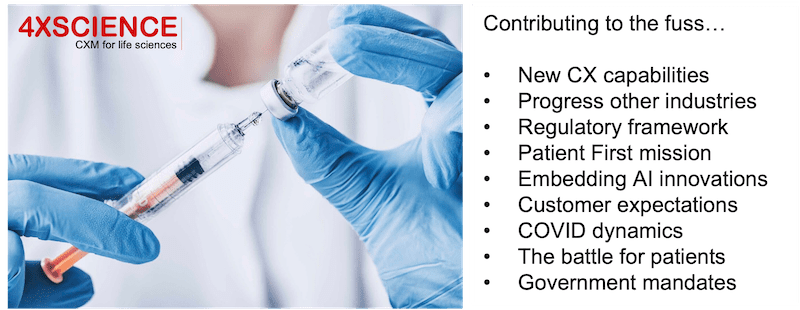
We explore the deeper "why" in another publication. As always, the theory is easier than the practice. We see many initiatives being stalled after their first excitement. Getting things done isn't that easy. CX and PX are not just about technologies, innovations or introducing new systems: processes and culture adoption, data integration, setting up customer centric environments, all prove to be more complex versus technology. Improving customer and patient experience in life sciences is a complex and significant effort. Many talk about CX and PX, without deeply understanding what is meant. Customer experience is not about improved "CRM functions", creating "memorable experiences", attempting to "exceed expectations" or using fancy "AI-enabled chatbots". There are huge opportunities in the way to approach customers and patients, but it is also strictly regulated, as well is the use of experience related data. Let's take a step back and clarify a few things.
Definitions: what is CX and PX?
In this publication, we aim to focus on the basic definition and understanding of CX and PX within life sciences. Without the fuss. As Certified Practitioners for Customer Experience (CCXP) and Certified Practitioners for Patient Experience (CPXP), we start from the formal definitions and adapt them to life sciences.
Customer Experience (CX)
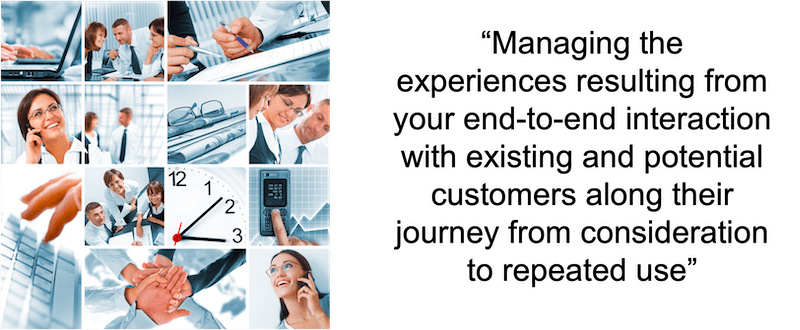
Important to understand is that we are talking about end-to-end interactions, from the first consideration or evaluation from your customer or potential customer, till repeated use during life time of the service or product. So CX is not about the one time interaction during the moments of purchase. It is the continued management of visible and invisible interactions and touchpoints you might have. In life sciences, that includes, for example, interactions with customers during clinical trials long before you supply large volume to distributors in commercial. The first experiences are created years before the sale. As long as you have potential customers, experiences are always present and balanced against their expectations, no matter if you choose to manage or ignore them. The well-know picture from Forrester Research used to explain the "experience economy" highlights how experiences must be first of all "useful", but in addition they need to be easy and enjoyable. In other words, experiences are subjective, personal, emotional, and continuously evaluated.
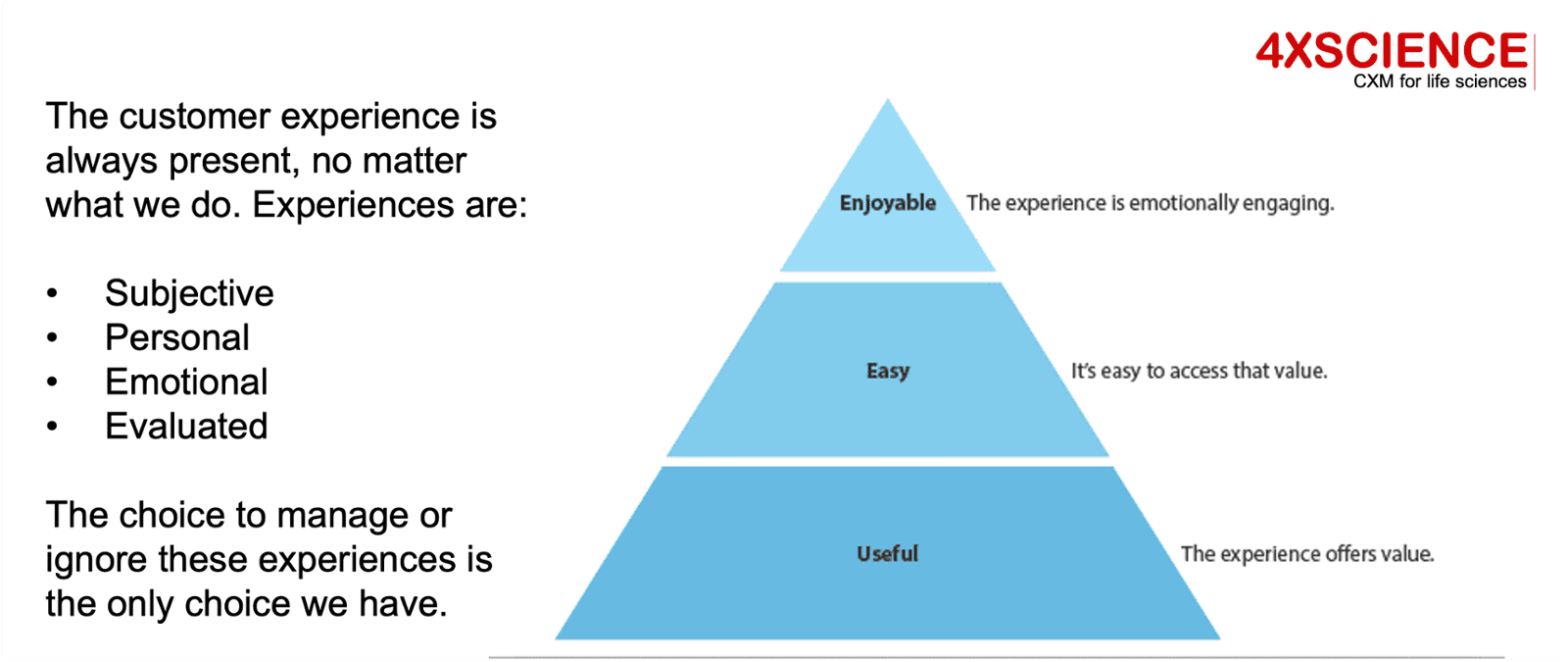
Those active in life sciences might question what is meant by "customers". Indeed, the landscape is extremely wide and examples include wholesale distributors, hospitals, doctors, surgeons, CEOs, competitors, pharmacies, opinion leaders, patient groups, patients, adults, children, elderly homes, ... The list depends on your role in the value chain and your role within your organization.
An interaction or touchpoint creates an experience, and can be defined as the way customers interact with the business, whether it be person-to-person, through a website, via an app or any form of communication. Examples include the use of products and services, but also the effectiveness of the treatment, the side effects, the lack of adverse events. And with this, the entire experience around it: follow ups, solving issues, deliveries, events, trainings, website information, feedback handling, surveys, sales meetings, negotiations, social media, reading, ... Customers have a significant series of touchpoints with your products and services. They usually have certain opinions long before they start to use your product or service. Of importance is to consider who or what is creating the interaction with these (potential) customers. This is not only your company, but also includes partners such as healthcare providers, management, employees, insurances, other customers, other patients.
Typically all of this is brought together in what is called a "customer journey". Journeys are to be defined for key customer groups, products, services and include all channels to interact. Touchpoints occur in a journey, which crosses multiple channels. Interactions are different per persona or role. If companies want to better "manage" experiences for customers, they need to understand how this fits into the overall business.
Here's an example of a generic customer journey which includes some of the more traditional non-life science specific tools such as email and social media. Many other examples exist when searching on Google:
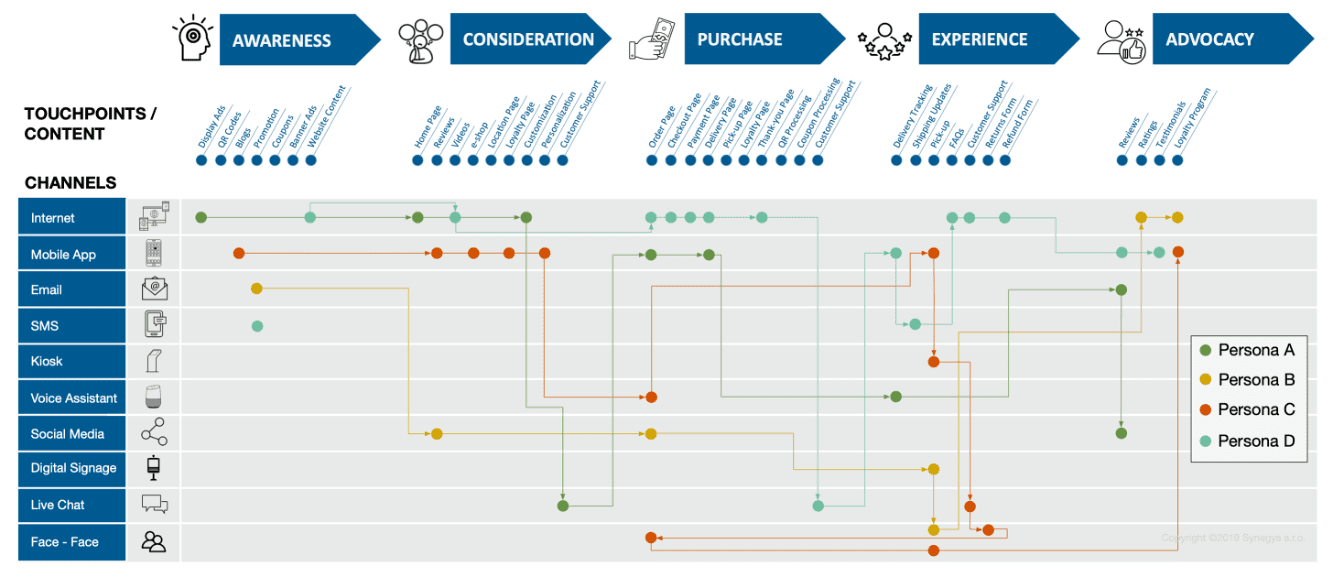
Whatever your role in life sciences, understanding the definition and the basic components is your first starting point. Making sure your team is aligned on what is meant by customer, experiences, end-to-end flows, parties involved, events responsible for interaction handling. Depending on your position in the supply chain, this assessment is unique for your specific organization, department, team. A hospital, a CMO, a high volume medical device distributor, a biotech start up in oncology: CX has a different meaning for each of them. CX strategies will be different.
Patient Experience (PX)
Spinning on from CX, to many organizations, the management of patient experiences might just look like another view in which we simply change customers by patients. Although there are similar principles that apply to both categories, patient experience management is another profession with its own dimensions, regulations, and objectives.
Let's illustrate this by simply looking at some elements that matter for patients: clinical outcome of procedures, immediate effect of medicines, single point of contact, ease of scheduling appointments, pain management, comfortable waiting areas, managing privacy of data, connecting with other caregivers and patients, administrative simplicity, a voice in development, access to scientific and objective information, life saving benefits from trials ... the list is long and filled with items often different from products only.
Without going too much into detail for now, let's introduce the following definition for patient experience (The Beryl Institute):
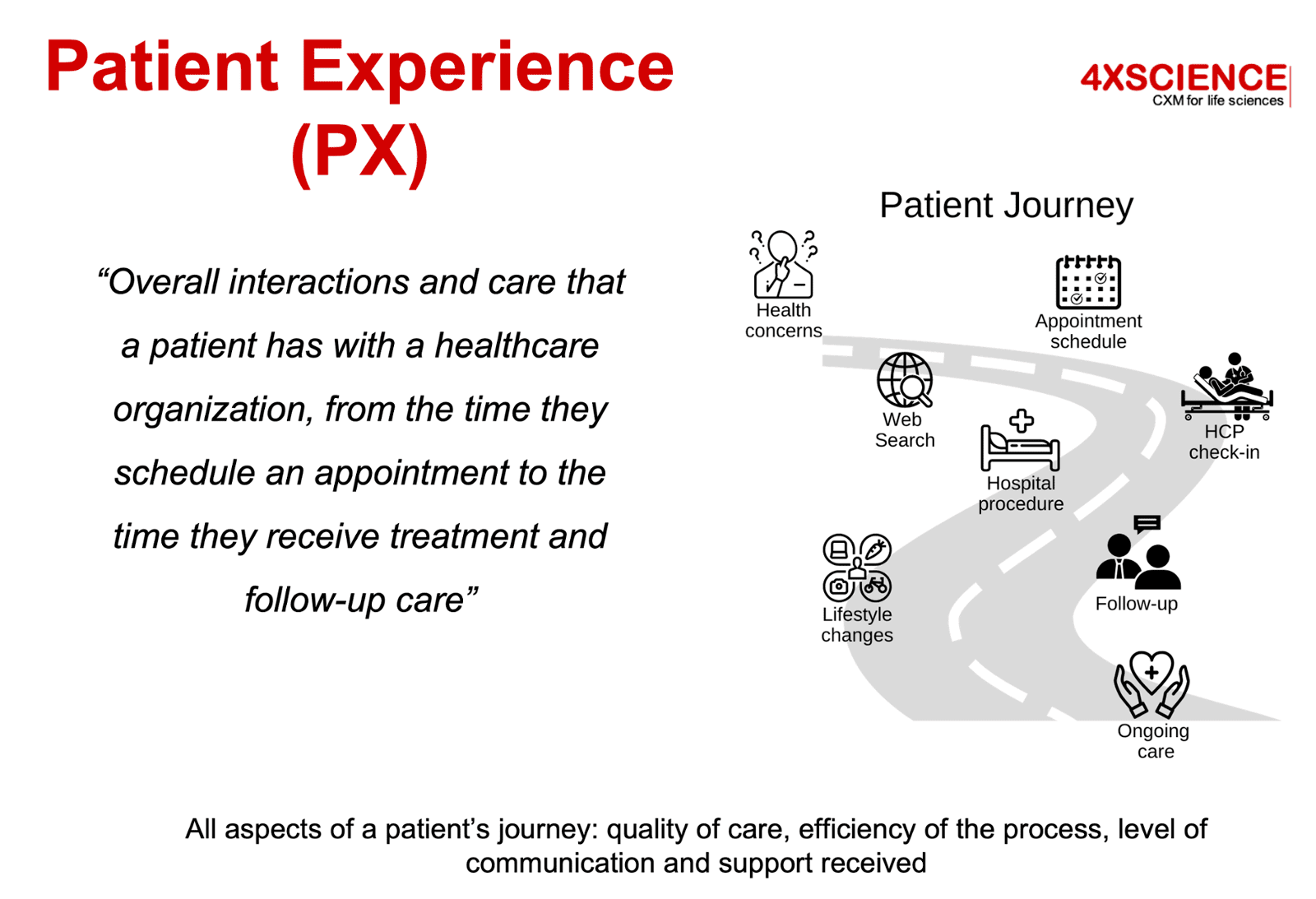
We are touching only one small tip of the iceberg here. The role of patients in their care to improve outcomes and safety, is a process that is being initiated from many directions. Likewise, people active in this domain, understand how the role of patients in the development of products, including clinical trials and pharmacovigilance, is under change since several years. In many countries hospitals receive financial support based on the results of patient surveys as governments aim to improve population health while reducing the cost of care.
While there are a lot of good similarities to leverage from CX concepts for improved PX, both concepts have fundamental differences. Although PX brings the necessary and additional value on top of care, it is not something that can be considered as "an extra feature" in life sciences. Patients are confronted with uncertainty, might be uncomfortable, anxious, have limited information, unclear outcomes, low empowerment.
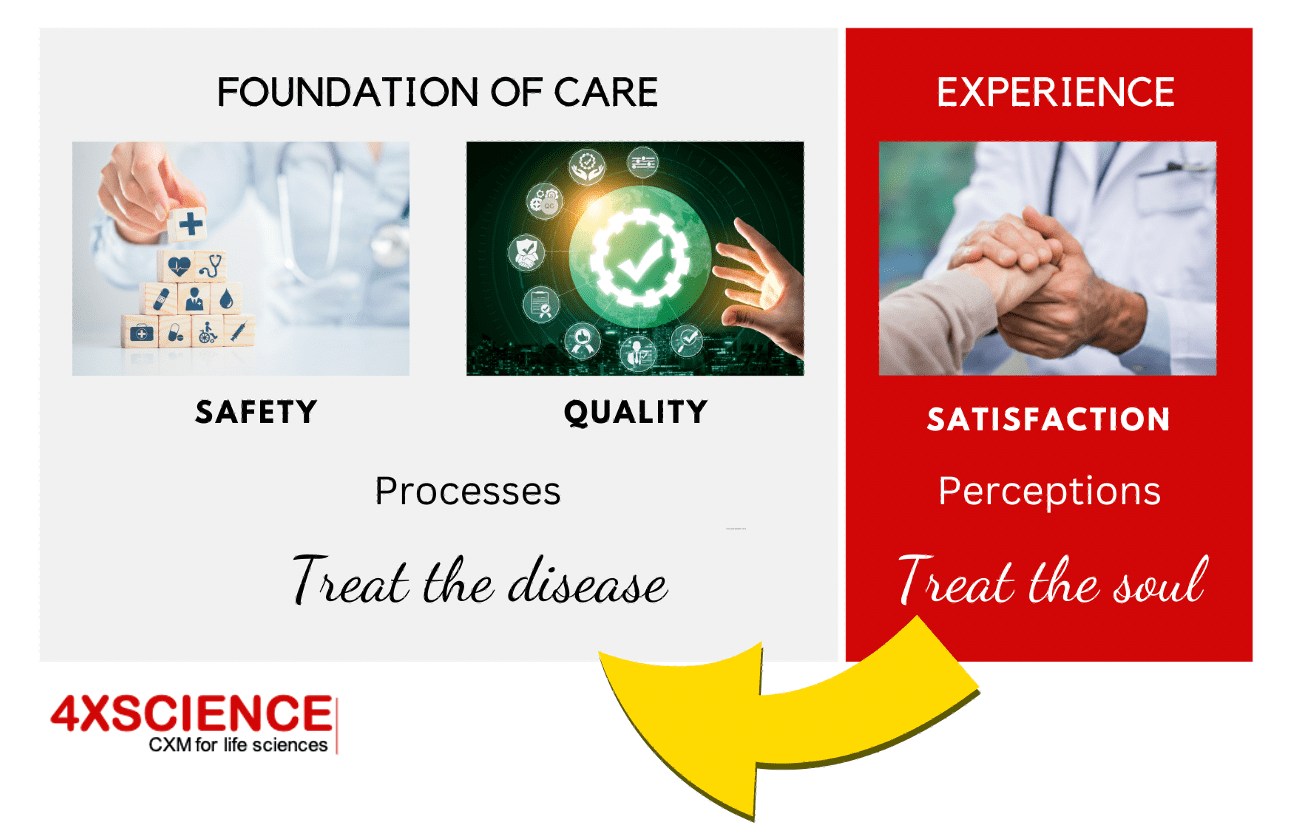
Management of the patient experience is important for all life science actors. It must be addressed across the entire value chain, with inclusion of all partners, and with deep understanding of the available capabilities.
In this publication, we introduced some very basic definitions for CX and PX, and started to paint the landscape. Working around CX and PX in life sciences, is not the same as applying these concepts in most consumer goods industries. Both concepts are now being deeply rooted in operational processes: life science actors are setting up specific teams, departments, and projects to implement and integrate specific parts of these concepts into their core businesses. A process that has been ongoing for several years with partial success so far. But the odds are changing. There is an entire science behind implementing CX and PX.
Who is our customer during different phases of the product life cycle? How can and should we interact with patients? Can we use experience data? What is patient-focused drug development? Are FDA and EMA aligned? What is the role of national, disease specific patient organizations? What boundaries do we need to respect? What are the opportunities? What do regulations allow? What guidelines do we have?
In our dealings with pharmaceutical manufacturers, distributors and hospitals, we recognize that many leaders have heard from CX and PX, sometimes lacking deeper insights. Knowledge is not always widely distributed internally, and/or managed by specific dedicated groups. More importantly, companies continue to struggle to get CX and PX to the right corporate agenda. While the value is clear to many individual teams, it is not yet to the organization. Teams in life sciences are growing fast, and hopefully, they are well designed for success. With our publications, we aim to create more awareness around the potential of CX and PX in life sciences. A first step in getting things done.
If this article was of any value, feel free to follow us for more details. What to get our letters in your inbox? click here

